| (001) 401-739-1140 -- (001) 401-739-1149 | |
|
| |
| Chainplates are the items by which the hull or deck is attached to the lower end of the Standing Rigging, usually a Turnbuckle. Most are made from Stainless Steel strap or bar and are bolted to the hull, to the cabin sides, or to a bulkhead and pass directly through the deck, usually through a Chainplate Cover bolted to the deck. Some are bent at the top to better align with the rigging loads. are designed to accept two separate shrouds at the same location. Less common are for use with Upset Toggle Turnbuckles, and which bolt directly to the deck. are bolted to the deck and/or hull at the stem for attachment of the Forestay, and sometimes incorporate an attachment point for a Jib tack shackle. Sometimes what would normally be called Chainplates are used as and the reverse is also true. Chainplates and Stemhead Fittings are listed below by configuration, and then by the size of the Pin they are attached to the rigging with. If you require Chainplates or Stemhead Fittings not listed here, we stock some others and are able to fabricate a variety of Custom ones, please forward a sketch with complete measurements and details for a quote. |
~ Back to Sailboat Hardware Main Page ~


Servicing The Chain Plates

Modern day chain plates are typically made of stainless steel and sometimes aluminum. When replacing a boat’s standing rigging one should also be sure to, remove, inspect , clean up and refasten the chainplate. Apart from design and material flaws there are three primary factors in the life expectancy of any chainplate: fatigue, age, and corrosion. One of the common misperceptions of stainless steel is that it does not rust. Depending on its grade, stainless steel is very resistant to rusting, but will rust and may do so prematurely when introducing chlorides (a.k.a. salt). If these chlorides are not able to be rinsed and removed, eventually rust colored deposits will begin to form. This in-itself presents a problem when sealing a chainplate to the deck or the hull in effort to keep water out. Chainplates that are mounted through the deck are the most suspect to crevice corrosion because once there has been any saltwater ingress, it is not likely possible to rinse or remove these salts from the surface of the metal. The only way to deal with chlorides is to remove the chainplate, clean off the rust deposits and visually inspect the plate material. Die penetrants or x-rays are a helpful tool in magnifying any areas of concern. Through-the-deck chainplates create an area of concern, where they pass through the deck, mainly due to the fact that it is right in-between the two pulling forces of the plate, i.e. the top bolt hole and the hole that accepts the pin for the stay’s turnbuckle. Through-deck chainplates are susceptible to failure because of this if not inspected regularly.
This brings me to the cover plate that mounts horizontally onto the deck. The chainplate cover plate is there to merely promote a seal. It is not structural, does not need to be through-bolted, and should be lifted, cleaned, and resealed every two to three years (give or take) depending on geographical location and use. This is both to preserve the decks core materials as well as keeping water out from below decks (Read our blog here on sealants and their uses).

Deck mounted chainplates will typically have few issues with failure within the actual plate (again, this is aside from fatigue, design and/or manufacturing flaws of course). The fasteners in this case are taking the ‘ brunt of it’ and care should be taken to ensure that the fasteners and/ or any associated tie-rods are in optimal condition. When removing the stainless steel fasteners you will see evidence of rust where they go through the deck. These types of chainplates should be resealed and have the fasteners replaced regularly (about every five to seven years, depending on use and geographical location).

U-bolt style chainplates, should also be pulled, inspected and re-sealed regularly. These types of chainplates should be replaced more frequently than the other styles. This is due to the fact that they depend solely on the threads used to fasten them through the deck.

In conclusion, chainplates are an often overlooked portion of ones rigging. I have even witnessed rigging shops that neglect to inform customers of the importance of chainplate inspection. If in doubt of your chainplate’s state, it is, at the very least it is a good idea to have them removed, cleaned up and inspected by a professional. If you are a do it yourself-er, there is no shame in seeking advice, not just for removal but most importantly for inspecting them as well as tips on installing them properly. So if you are having your boat re-rigged, be sure to ask about those chainplates.
REMEMBER: Don’t forget to replace the fasteners!
Have a question, leave us a comment or shoot us an email and we will be glad to reply!
Similar Posts
Extreme 40’s hit brazil.
These are the highlights from act 8 in beautiful Rio De Janeiro. Torben Grael, skipper of Team Brasil and home town hero could not make it happen. Leigh Mcmillan of The Wave Muskat takes the double and probably has the best finishes for 2012. Great job, Team Muscat! I can’t wait to catch the action next year in Oman……….
A Foiling Wonder
Here are some great shots of Oracle Team USA’s Hydro-foiling AC 72in action. Insane! I can’t wait to see them all on the race course. This will indeed be a Cup to remember….. Images courtesy of Guilain Grenier. …..and as a bonus, some AC 45 highlights. [youtube http://www.youtube.com/watch?v=j3Nfjy3yQYs&w=560&h=315]
The Future is Now
Is the wife complaining about the boat heeling too much and you don’t want to make the switch to a catamaran. Who can blame you. Well, there is great news for mono-hull enthusiasts. Infinity Yachts is breaking new ground with dynamic stability control via a horizontal foil. This is a well made video (I thought) and now…
The Best Scissors Ever…
…At least for cutting boat rope. Viper Kevlar Shears cut Kevlar (especially), but are also great for other tough fabrics like Dyneema, Vectran, Polyester, Technora. Apparently it is also used in cutting plastics, canvas, and even body armor. Yes, of course they’ll go dull after a few years of cutting tough fiber rope, but they carry a…
Swageless Mechanical Fittings or Swage Terminals…
…Which do you prefer? When talking about wire standing rigging for sailboats, there are two primary ways to secure a fitting to the end of the cable, the swage fitting and the mechanical fitting. One requires a specialized, expensive machine (pictured below) that is used to essentially squeeze or hammer the fitting onto the wire,…
Trans-At in Less Than 5 Days
Last week the Krys Ocean Race offered us a look at the new MOD 70’s. Check them out as they race across the Atlantic, proving both speed and stability. [youtube http://www.youtube.com/watch?v=OHXHIXekpxE&w=560&h=315]
Leave a Reply Cancel reply
Your email address will not be published. Required fields are marked *
Save my name, email, and website in this browser for the next time I comment.
23 Comments
I have a 1983 Bristol 35.5 that has been determined to have moisture in the knee for the backstay chain plate. The knee is sound but definitely has moisture in the wood core. To replace the knee is nearly impossible due to access to the area.
I’m strongly considering an external chain plate in the general area of the current internal mounting knee. The chain plate will only require a slight bend to reflect the necessary angle of the back stay.
The ideal thing would be to repair the knee in such a fashion that it was structurally sound though. Regardless, I think that removal of the old chainplate be done. Perhaps the knee is just wet and not rotten (fingers crossed). If so, let it dry and maybe treat that area with epoxy. At the same time inspecting the plate, cleaning and polishing it once over. Then replacing the fasteners and re-sealing the cover-plate is likely a good idea.
A fiberglass specialist will likely have the best advice here and I would ultimately seek their advice.
The final concern is with hull integrity for mounting and external chainplate to the transom. Maybe glass reinforcements need to be made to ‘beef-up’ the affected area!
Also are there other Bristol owners (on the internet) that have had this issue and what was there fix?
Just some thoughts. Hope that helps.
Thank you for your prompt reply.
According to my boat yard, to gain access to the back stay knee area would require dismantling the pedestal, dropping the rudder, etc. They have quoted the job as a $7,000 repair. Yes, the core material is mushy.
The idea of changing to an external chain plate is based on the fact the current knee is glassed to the interior transom.
I have a 1975(?) Cascade 36, with the chain-plates and stem head fiber-glassed into the inside of the hull. I have been vigilant in maintaining a seal at the deck but have not idea what the previous owners may have done. I do see evidence of slight rust around the pins that protrude inside the hull laminate but no evidence of water leaking in. I was considering just having new chain-plates made, bolting them on the outside using the existing ones for backing plates. Have you heard of such a fix? Have you ever done one of these boats? and, if so, would you have a better suggestion?
Yes, we have done this before. I would recommend just bolting the new ones to the outside for future ease of inspection. I would however go through the effort of cutting out the old plates. Inspecting the hull and deck around the affected area, make any repairs as necessary and seal everything with resin glass and paint. This is not only for a finished look, but will also ensure that further water intrusion in the future…AND it will make sure that the hull and deck are structurally sound. The last part is, it is horrible to drill those old SS chainplates, especially in the boat. The backing plate idea doesn’t really add a tremendous amount of strength, it is better to ensure that the fiberglass (which is doing the brunt of the work along with fasteners) is sound.
Thanks for the comment.
Thanks so much for that, It certainly seems an easier way. My priority will be the fore-stay If you’ve already done one of these, on a Cascade 36, could I buy the chain-plates from you? If so, what will they cost me?
Yes, you can certainly have us make them. We would use a water jet machine to cut them out and polish the tips and the part facing OB for longevity. The plates may run around around $400 per plate, a bit more because they are water-jetted. This is a much nicer way to make holes in metal, instead of tempering it with drill bits. If you send me some rough dimensions, included with a drawing that may depict any bends, I can get you firm quoted price within roughly a week. Time to complete once ordered is about to weeks.
Thanks again and if interested please email us at [email protected]
Mine is a Cape Dory 30K 1978. The chain/backing plates look like Baklava. .I just got the boat and plan to haul out next week to start the process. They used iron backing plates with welded rebar glassed to the hull would you recommend something better? I don’t want to put exterior chainplates I would like to keep things the same but maybe different material.Thanks
Hey John, I love Baklava, but not made of Iron. Do you have any pictures you can email us? The CP’s on deck are pad eyes made of bronze, right? It may be ideal for the backing plate to be made of 316 grade stainless…even G10 composite may be a nice upgrade. Oh and definitely replace the screws. Please email [email protected] for the pics and further advice.
Do you have any information please on repairing chainplates on a Colvic UFO 34. One has gone rusty inside the firbreglass. Thy are below deck inside the saloon and are encased in fibreglass. Do you make these chainplates? Paul
Thanks for commenting. We don’t have specific experience with this boat, but we have dealt with galssed-in chainplates in the past. You will likely do best by consulting a fiberglass specialist for tips and adivce on getting them out. Depending on the age of the boat, it especially sounds like you should try and get them removed and inspected at the very least, perhaps replaced, and then re-install them…all of them. Typically we have found a bolt on solution on most of these projects for the install. This will entail new chainplates to be made.
Feel free to send us some pictures and ask more questions if you need to.
Thanks, ~T.R.C.
I have a Rawson 30 and cant find any information about removing or replacing the chainplates, do you have any resources or any experience with these boats? the originals seem to just be glassed in as i cant find any bolts but that doesn’t really make sense..
Hi Kelly, thanks for the comment. It would be hard to say as most boats have so many variations for the chain plate install. However, your comment couldn’t have better timing, because I am going to look at a Rawson 30 within the next two weeks for a furler replacement. While I am there I will also take a look a the chain plates and make some recommendations for you based on this.
Talk to you soon…. Jim
….I hope this helps and thanks again for commenting.
That’s exactly what I did. Thanks for the reply.
i have a rawson 30 and i am dealing with the same issue now.. anychance you could send me a pic of what you did? thanks scott [email protected]
I don’t have any immediately available but still have access to them. Check in on this comment section once and a while and I may end up uploading some.
What we did was, have them cut out from the inside (some interior removal and modification necessary). We then installed them mechanically, again on the inside of the hull, but through bolted form the outside using polished carriage bolts. Then we made new ones as well as a custom “T” plate that was married in via the top bolt hole. This helped spread the load to the underside of the deck at the toe rail… a very strong corner. This was done primarily because the hull material seemed a bit thin. I guess an alternative might be to reinforce the hill in patches from the inside via fiberglass laminates. This is just the route we chose this time around. Hope that’s not all too confusing . In the end we added chainplate cover plates, screwed into the toe rail, to create a proper seal.
Hope that helps… ~T.R.C.
I have had a local boat yard re-fasten chainplates on a wooden hull ( first removed and then re-fastened in same position) and bungs from screws into the ribs have popped out in various places next to the chainplates. Is this because the chainplates have been screwed down too tight? My feeling is yes, and they should have been just “snugged up”. To make matters worse, the boat has been out of the water for two years so she will experience significant swelling. The hull is strip built pine, edge nailed and then screwed to frame (where the bungs have popped). Please advise.
It is hard to say for sure. It does seem that the chainplate job has something to do with it, as the affected area is around the chainplates. However, it also a wooden boat and there is a lot of movement in wooden boats (especially when going from completely swollen to completely dry). This movement may have just caused the bungs to pop around the newly fastened chainplates because the chainplates being fastened to the hull now offer a now stiffer reinforced area to the hull, so instead of the wood moving evenly throughout it runs into a hard spot where these plates were fastened. Then again it could be a number of other reasons, so it is hard to say.
I may just put the boat in the water and let her settle in for a while then go around the hull with a raft and refasten and re-bung as needed. Because if the boat has been dry for a while it will certainly change shape a good bit once swelled. I am sure other things will happen like maybe some of the seems may need to be re-caulked. You just won’t know until she is wet again and settled in. For this reason alone I think it is always prudent to wait until the boat is wet to caulk, bung, refasten, even paint the hull above the water line. A good raft can be a useful investment.
Thanks for the comment and let us know if we can help any further!
I have a Hudson Force 50 one of the chain plates has a hair crack do you make these style plates
We do! We would recommend that all of the plates and fasteners get replaced simultaneously. We would need the plates that are to be replaced for duplicatuon. If you can send a picture of the chainplate style I can provide you a quote for replacement. Thanks for the comment! ~T.R.C.
I’ve noticed heavy rust stains around the port chain plate of the mast rig on a 2005 Bavaria 38 C. lying in Denia/Spain. What could be the reason and what is the best and most economical procedure to follow? Can I do this on my own? Thank you for your attention.
This seems like a fairly new boat and the first thing I might do is contact Bavaria to see if this is something they have encountered before. Reasons for excessive rusting could be: 1. Poor quality stainless 2. The stainless has somehow been contaminated with steel or iron 3. It could also be that the metal is covered by grease, sealant, dirt or some other substance that can cause oxygen to not be able to get to the metal. Stainless steel can rust, especially when it can’t breathe. If Bavaria is of no help, then you can remove the chain plate, clean the rust off with a stainless steel wire brush, polish it, remove any excess Polish with acetone and inspect the plate for cracks and other issues. Reinstall using new sealant and monitor the plate for the next few years. If the rust returns, I would have a new chain plate made. To remove the chain plate with the mast up make sure you properly secure this side of the mast with multiple halyards and detune the the opposite shrouds. Removal is easiest when the mast is out of the boat. Hope this helps and thanks for the comment!
Username or Email Address
Remember Me
Lost your password?
Review Cart
No products in the cart.

- Privacy Overview
- Strictly Necessary Cookies
This website uses cookies so that we can provide you with the best user experience possible. Cookie information is stored in your browser and performs functions such as recognising you when you return to our website and helping our team to understand which sections of the website you find most interesting and useful.
Strictly Necessary Cookie should be enabled at all times so that we can save your preferences for cookie settings.
If you disable this cookie, we will not be able to save your preferences. This means that every time you visit this website you will need to enable or disable cookies again.
- BOAT OF THE YEAR
- Newsletters
- Sailboat Reviews
- Boating Safety
- Sails and Rigging
- Maintenance
- Sailing Totem
- Sailor & Galley
- Living Aboard
- Destinations
- Gear & Electronics
- Charter Resources
- Ultimate Boating Giveaway

Chainplates 101: Inspect and Refit
- By Tom Zydler
- Updated: November 15, 2013
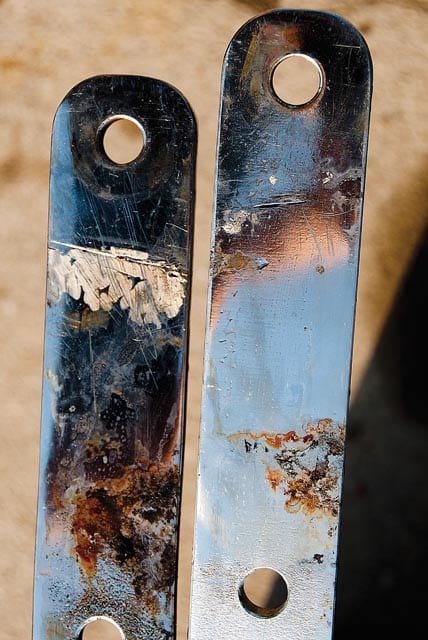
Corroded Chainplates
Out of sight and out of mind: For many sailors, that’s an apt description of their chainplates, the stainless-steel fittings protruding through the deck that anchor a mast’s standing rigging wires. In typical installations, the longer portion of a chainplate is hidden below deck in a locker, where it’s difficult to see or inspect. It’s no wonder that many sailors on the cusp of bluewater cruising focus on beefing up or replacing the standing rigging while assuming the chainplates will continue supporting the wires that keep the mast erect.
For safety and peace of mind, however, sailboat chainplates require attention and possibly upgrading. For example, many chainplates are too thin to grip clevis pins correctly. For a ½-inch turnbuckle with a ½-inch toggle, the chainplate should be at least ⅜ inch thick. For a ⅝-inch turnbuckle and toggle, a minimum thickness of ½ inch is necessary.
Another matter worthy of consideration is the stainless-steel alloy the boat’s chainplates are made of. Though 304 stainless is widely used, it’s prone to crevice corrosion when seawater seeps past bedding compounds and becomes stagnant on the metal, thus rendering it a poor choice for chainplates. (This also illustrates the danger of relying on sealants to protect from moisture chainplates that are led through the deck.) When polished to a high gloss, 316L stainless will survive much longer. Grade 2 titanium is ideal, though its high price makes it cost prohibitive for most yacht applications.
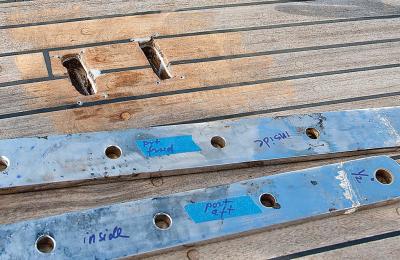
| |In this image, the damaged balsa core, which is typical in older classic-plastic production boats, is visible through the deck slots. Make sure to mark and identify the old chainplates before giving them to the fabricators. They will mark the new ones accordingly.| |
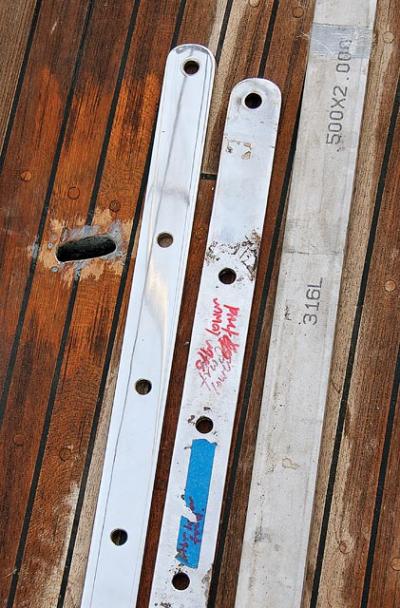
| |Three degrees of chainplate separation: the old chainplate (center), the new 316L bar stock (right) and the finished, polished, brand-new chainplate (left).| |
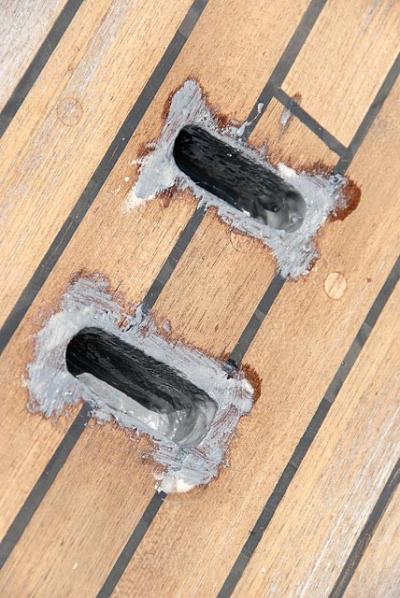
| |The real key to a chainplate replacement job will be how well you effect the repairs to the old balsa core and the deck slots. For my project, I cleared about an inch of balsa core from between the layers of deck laminate and rebuilt the area with thickened epoxy. This not only stiffened the deck, but also created a wall of solid epoxy that would protect the balsa from seawater in the event that the sealant broke down.| |
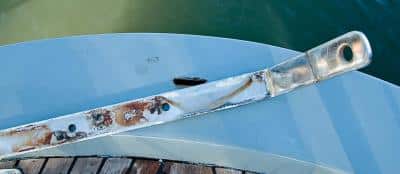
| |Once the backstay chainplate was pulled, it was clear how the corrosion started (where the metal was seated against the teak transom), and where water was trapped near the through-transom fasteners. I corrected this by enlarging the slot in the teak and inserting a rubber gasket where the new chainplate meets the transom.|
In any case, preventing seawater from leaking down the chainplates is essential. Boatbuilders routinely squeeze bedding compound between the deck and the chainplates before installing stainless cover plates. These screwed-in deck plates are supposed to compress the sealant around the chainplates. However, they are often too small to be effective, and furthermore, they embrace the chainplates so tightly they actually trap water in the worst possible location.
Thoughtful design and building practices would help prevent future problems. To maximize upwind tacking angles, racing boats often have chainplates installed well inboard, and these must be led through the deck. Since many owners of dual-purpose performance cruisers also use their boats for racing, many production sailboats have a similar arrangement for tight headsail sheeting. But even with a narrow rigging base, it’s possible to improve the chainplate installation. Some builders specify chainplates welded to a base that is then bolted through the deck onto a strong under-deck plate that’s sometimes backed by a tension rod. In such a setup the topside component can be sealed with a neoprene gasket, which is more effective than a bedding compound that can be squeezed out when the bolts are tightened. Also, this arrangement permits easy inspection of the fitting and its fasteners for smudges of rust, the first sign of creeping corrosion.
On cruising boats, it makes more sense to situate the chainplates outboard, on the outside of the hull. This provides a very wide, efficient base with longer spreaders and a wider angle between the shrouds and the mast, all of which reduces the loads on the rigging wire. The venerable Out Island series of boats designed by Charley Morgan has such chainplates, which are easy to inspect and reduce the risk of crevice corrosion. While they can still corrode on the underside where seawater can get trapped, their generous thickness provides a welcome safety factor.
All bolts holding chainplates require frequent inspections. Fashioned from 304 stainless alloy (also known as 18/8), the threads on these fasteners can collect saltwater and they can corrode quite easily. When sailmaker Dave Beatson began to remove some chainplate bolts on his Creekmore 34, half of the bolt heads fell off when he turned the wrench. So when we bought a 20-year-old Mason 44, I decided to pull out the chainplates to see what, if anything, was going on.
Ominously, I discovered that corrosion — some of which looked like the beginning of straight saw cuts — had begun to disintegrate the metal right where the chainplates vanished through the deck. And the backstay chainplate was losing metal below the deck where the bolts went through the transom. To address the situation, Peter Messenger, one of the most experienced riggers I know, advised using 316L stainless alloy for repairs. After cutting the material to size, he advised polishing it to high gloss. I ordered lengths of 316L bar in ½-inch and ⅝-inch thicknesses to match the size of the turnbuckle toggles for the lower and upper shrouds, respectively. (The original chainplates were much thinner and, while probably still strong enough, the clevis pins had a loose, sloppy fit. Also, the new bar stock I’d ordered was very slightly undersize, making it a perfect fit with the toggles.)
When effecting repairs or refits, ideally the deck area around the chainplates should be a solid glass laminate. It wasn’t on my Mason, which again is typical for most older production boats. So I cleared out about an inch of balsa core from between the layers of deck laminate and rebuilt the area with thickened epoxy. This stiffened the deck. Also, if the sealant broke down, the wall of solid epoxy would prevent seawater from soaking into the balsa and creating a permanent sponge bath, ensuring accelerated corrosion. To prevent future leaks, I discarded the slim stainless cover plates affixed to the original chainplates. Out of prefab fiberglass plate I then made larger cover plates with slots ½-inch wider than the chainplates.
This allowed a generous buildup of BoatLIFE polysulfide sealant. Before sealing, I wiped all metal parts with degreaser to remove any contaminants. When choosing a sealant, avoid the tenacious 3M 5200 polyurethane so beloved by certain boatyard workers because it hides bad workmanship. Plus, it takes days to set. Use 5200 only where you want the pieces to bond permanently. Although it slowly cracks when exposed to sunlight, you’d still need a heat gun and an iron will to remove it later.
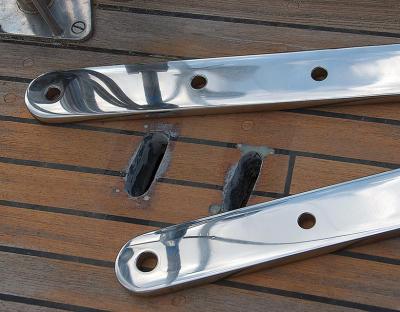
| |The new, polished chainplates for the intermediate and upper shrouds are ready to go in.|To prevent future leaks, I discarded the original stainless cover plates for the original chainplates and replaced them with larger cover plates fabricated from prefab fiberglass sheets.|I bedded the new cover plates with a buildup of BoatLIFE polysulfide sealant.|
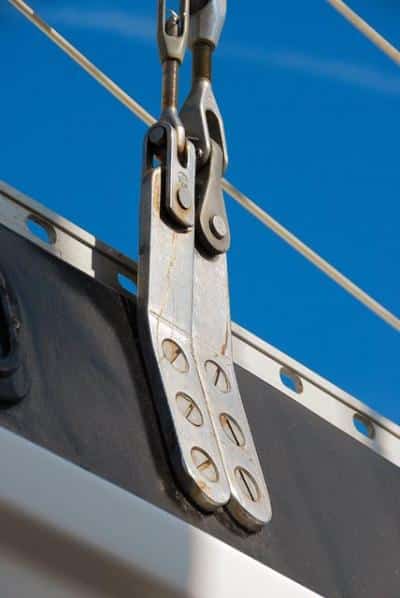
| |Belowdecks, the chainplate fasteners pass through a long 1/8-inch backing plate.| |
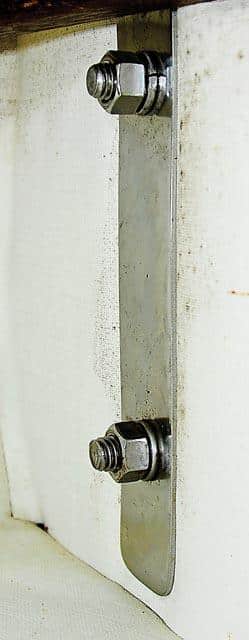
| |Outboard chainplates also work well. Note how the popular U-shaped toggle is beginning to corrode while the old forged bronze toggle is clean.|
Because I tackled the project with the keel-stepped mast still in place, I worked in stages. First I removed the chainplates servicing the lower shrouds; then I made a notation with a marker signifying their locations; finally I brought them to the fabricators to duplicate in the new material. In the calm waters of a protected marina, the upper and intermediate shrouds supported the mast adequately while I worked.
After the lower chainplates were reinstalled, I repeated the steps with the intermediates and then the upper shrouds. The backstay chainplate was the last to go back in: Tension on the mainsheet and the topping lift provided the mast with reasonable fore and aft support.
All this work boosted our confidence in the rig considerably. A month later, knowing our spar was suitably reinforced, we sailed north from Florida to Labrador.
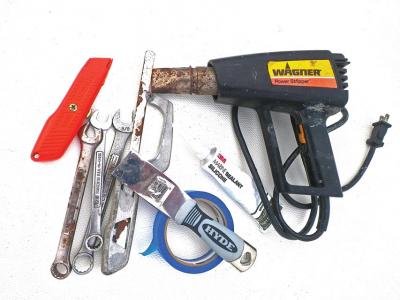
| | Tools for the Job • Wrenches to match and fit the fasteners • Heat gun to soften the old sealant around the chainplates • A narrow metal blade to cut through the sealant adhering to the chainplates • A 90-degree hook (homemade) to scrape balsa core out of the chainplate slots • Epoxy resin and hardener to build up the space left from removing balsa; plus West System 404 High-Density filler additive; a putty knife and gloves • Wide masking tape and duct tape to build up a “dam” that will prevent epoxy from dripping into the boat’s interior • Sandpaper from 40- to 60-grit to smooth out the cured epoxy • Polysulfide sealant and caulking gun • 1-inch-wide masking tape to protect the deck and the upper part of the chainplates from sealant leakage| |Longtime CW contributor Tom Zydler and his wife, Nancy, spent this summer exploring the coast of Labrador and surrounding waters aboard their Mason 44,_ Frances B_.|
- More: DIY Sailboat Projects , How To , sails & rigging
- More How To

Striking the Balance: Comfort, Complexity, and Accessibility


Cruise Control: Heavy Weather Sailing Advice

Sailing Totem : One Nice Thing

Pain Is the Ultimate Teacher: Hard Lessons in Seamanship
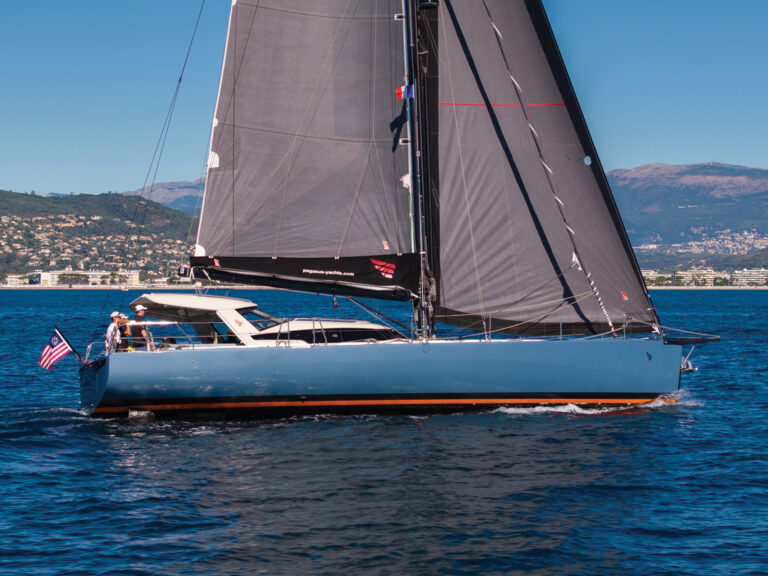
Cruising with Confidence: How Modern Boats Are Measuring Up
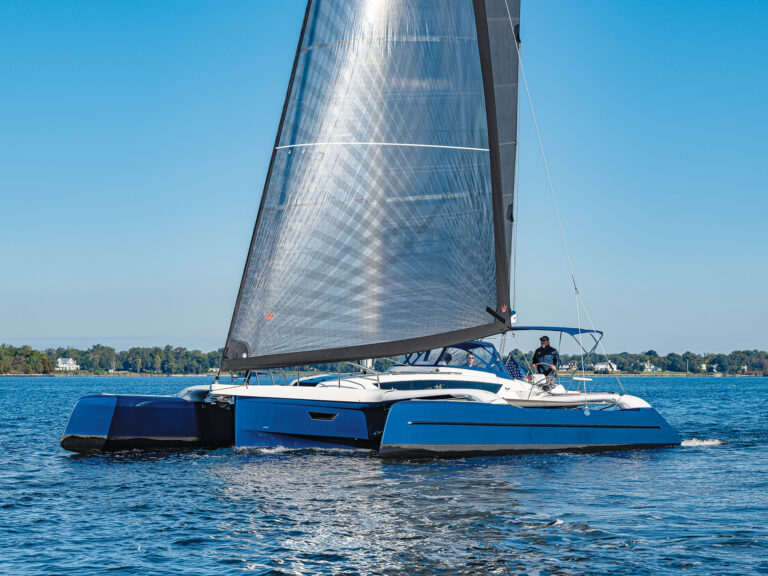
Sailboat Review: Dragonfly 40

Sailor & Galley: Easy Pink Aioli Dip

Reefs at Risk: How Cruisers Can Champion Ocean Conservation
- Digital Edition
- Customer Service
- Privacy Policy
- Terms of Use
- Email Newsletters
- Cruising World
- Sailing World
- Salt Water Sportsman
- Sport Fishing
- Wakeboarding
Visit our Popular Forums
- Monohull Sailboats
- Multihull Sailboats
- Powered Boats
- General Sailing
- Antares Yachts
- Fountaine Pajot
- Lagoon Catamarans
Cruising Business
- Boat Classifieds
- General Classifieds
- Crew Positions
- Commercial Posts
- Vendor Spotlight
Life Aboard a Boat
- Provisioning: Food & Drink
- Families, Kids, & Pets Afloat
- Recreation, Entertainment, & Fun
- Boat Ownership & Making a Living
- Liveaboard's Forum
Seamanship, Navigation & Boat Handling
- Seamanship & Boat Handling
- Training, Licensing, & Certification
- Health, Safety, & Related Gear
- Rules of the Road, Regulations, & Red Tape
Engineering & Systems
- Const. / Maint. / Refit
- Product / Service Reviews
- Electronics: Comms / AV
- Electrical: Batts / Gen / Solar
- Lithium Power Systems
- Engines & Propulsion
- Propellers & Drive Systems
- Plumbing / Fixtures
- Deck Hdw: Rigging / Sails
- Aux. Equipment & Dinghy
- Anchoring & Mooring
Photo Categories
- Member Galleries
- Life Onboard
- Sailing in the Wind
- Power Boats
- Cruising Destinations
- Maint. & Boat Building
- Marine Life
- Scuba Diving & Divers
- General Photos
Recent Photos

Listing Categories
- African Cats
- view more »
- Crew Wanted
- Crew Available
- Enhance Your Account
- Meet the Mods
- Meet the Advisors
- Signup for The Daily Cruiser Email

IMAGES
COMMENTS
Chainplates are the items by which the hull or deck is attached to the lower end of the Standing Rigging, usually a Turnbuckle. Most Standard Chainplates are made from Stainless Steel strap or bar and are bolted to the hull, to the cabin sides, or to a bulkhead and pass directly through the deck, usually through a Chainplate Cover bolted to the ...
Feb 2, 2015 · Reinstall using new sealant and monitor the plate for the next few years. If the rust returns, I would have a new chain plate made. To remove the chain plate with the mast up make sure you properly secure this side of the mast with multiple halyards and detune the the opposite shrouds. Removal is easiest when the mast is out of the boat.
Nov 15, 2013 · When effecting repairs or refits, ideally the deck area around the chainplates should be a solid glass laminate. It wasn’t on my Mason, which again is typical for most older production boats. So I cleared out about an inch of balsa core from between the layers of deck laminate and rebuilt the area with thickened epoxy. This stiffened the deck.
Jan 30, 2020 · Considering how dynamic the loads are on a sailboat, Colligo therefore sizes all its titanium chainplates to have the same physical dimensions as the stainless plates they are replacing. This results in a two to three-times increase in the safety factor, with chainplates that are still 40 percent lighter than the original.
Manganese Bronze Chain Plate - Lightweight. Manganese bronze chain plates from Spartan Marine in the USA. These small burnished fittings provide robust deck mounting points for rigging and other purposes. They are particularly suited to shrouds and backstays. With a 1/4" clevis, these...
Jan 9, 2022 · Hi all, I'm going to be adding a staysail chainplate to my boat this spring and need a little advise in order to properly protect the core. The 2.5" x 1/4" stainless bar will be attached to a bulkhead in the chain locker and come up through the deck.